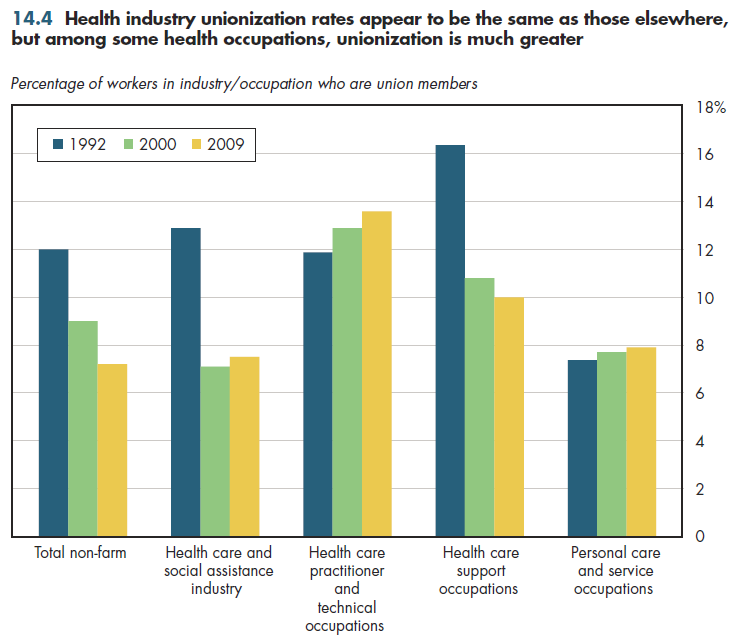Download PowerPoint versions of figure.
Inside Collection (Book): American Health Economy Illustrated
14.4 Unionization Rates in the Health Industry
Summary: Unionization rates in the health industry are comparable to the economy-wide rate. The unionization rate within some health occupations is much higher.
The percentage of health industry workers who are union members appears to be the same as the national rate of unionization among all workers. At the industry level, the available data combine health services workers with other social assistance workers. Because the latter group constitutes only 15 percent of the combined total, it is unlikely that the numbers shown in figure 14.4 would change much if unionization in the health industry were measured more precisely. That said, at least part of the apparent steep decline in unionization for this group between 1992 and 2000 might be a statistical artifact. During that time, a major change occurred in how industries are categorized; the groups being compared in these two years are not identical in composition. It seems likely that there was a decline in unionization but perhaps not to the extent shown. The apparent rise in unionization from 2000 to 2007 cannot be explained in a similar fashion. It likely is genuine (though small).

Unionization data also are available at a more detailed level for health-related occupations. Shown are the numbers for the broad aggregates used by the BLS to describe health sector workers. Thus, among health care practitioner and technical occupations, the unionization rate is approximately double the rate for all health services. Moreover, this rate appears to be increasing over time. In contrast, unionization seems to be declining among health support occupations (again, with the caveat that the steep decline from 1992-2000 likely is exaggerated). "Personal care and service occupations" is another imprecise aggregate. It includes personal and home care aides, but these constitute only approximately one-sixth of the workers in this category. It also includes those who provide personal care services such as haircuts or manicures. Unionization within this group is similar to the economy-wide average and might possibly be increasing. Because identifiable health workers account for a much smaller group within this total, it is conceivable that these numbers would be different with numbers that are more detailed.
Downloads
References
- Department of Commerce. Bureau of the Census.
- Department of Labor. Bureau of Labor Statistics.
Collection Navigation
- « Previous module in collection 14.3 US Health Sector Is Highly Regulated
- Collection home: American Health Economy Illustrated
- Next module in collection » 15.1 Health Spending per Capita Has Grown Twice as Fast as per Capita Net Worth
Content actions
Give feedback:
Download:
Add:
Reuse / Edit:
Twin Cities Campus:
- © 2012 Regents of the University of Minnesota. All rights reserved.
- The University of Minnesota is an equal opportunity educator and employer. Privacy
- Last modified on Sep 25, 2013 2:28 pm -0500









